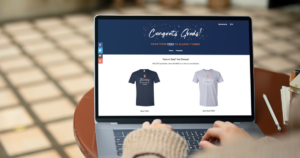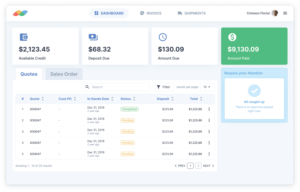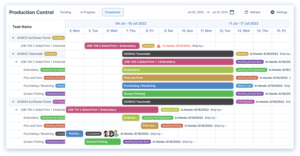Are you interested in working smarter, not harder? Would you like to spend less time and energy on mundane business functions and more time on important things like researching new markets and strategizing how to make more money?
If so, there is no faster, easier way to become more efficient and productive than to incorporate an industry-specific management software system into your business.
While the price tag may have been a barrier for smaller shops in the past, competition and new players have dramatically lowered the cost, to the point there’s really no excuse for even a prosumer home-based business to not take advantage of the automation available. Entry level programs these days can be had for as little as $69 a month—less than some people will spend at Starbucks over that same time period!

Online stores are vital to today’s decorated-apparel companies. Photo courtesy of InkSoft
“If you’re using Excel and a pen and paper, it works well in the beginning when you’re small,” says Anbin Muniandy, CEO of YoPrint, a software company providing what it describes as all-in-one print shop management software. “But as you add employees, the paper system falls apart, because when you update something on paper, the other employees don’t know.”
Per Muniandy: “With software, I update something on my screen, then production can pull up the order, and the customer can see it in the portal. It saves time spent on communication.”
Similarly, on the sales side “you need to make it easy for your customers to buy from you,” says Craig Mertens, director of education at Inktavo, which includes the InkSoft, Printavo and GraphicsFlow brands and specializes in creating “software for the branded merchandise industry,” with products designed to do everything from organize your print shop to modernize your graphics department and sell more merch online.
“Prior to the pandemic, you could get away with not offering e-commerce or being overstaffed. But in the current business climate, companies have had to staff down and lean into technology to make up for that,” he says.
In addition, Mertens says, “As consumer habits have shifted, more people are making decisions based on online research, choosing graphics online and using e-commerce to make purchases. If you are not evolving with this new business climate, I believe it’s not only going to be difficult to grow, you are going to struggle to maintain.”
Along these same lines, Erich Campbell, program manager with embroidery specialist Briton Leap/Embrilliance, says, “In any size business, there is information that is needed on a repeat basis from customers to employees. Software’s superpower is the ability to immediately access this data…One thing I see people struggle with continually is information workflow. A customer calls and wants to reorder the same thing as a year ago. You need to know not only what it was, but exactly how you executed it.”
How Big Does Your Apparel Business Need to Be?
For the newcomer, adding on the cost of software to their already long list of capital expenditures may seem extravagant. But in reality, it’s an investment that allows for faster growth and, by extension, will ultimately pay for itself—the same as any other smart investment—by allowing you to spend your time on those aspects of your business only you can do, versus those tasks better suited to a computer.

Customers can keep tabs on their order status directly. Image courtesy of YoPrint
“I think a company should consider adding software early on,” Muniandy emphasizes. “Some programs are expensive, but not all are. If you are doing only a few orders a month, maybe it’s too soon. But if you are doing a few decent orders a week, you’re already earning enough revenue to justify the cost. It may not be a full-featured program, but something to get started with.”
Campbell agrees, saying, “I think there’s a bridging point between the person selling pre-decorated products at a craft show and a prosumer doing customization, for example, a monogram shop or a business adding logos and names to uniforms. At that point, you are doing enough throughput to justify the cost.”
In the same vein, Mertens says, “I suggest looking at business software as an employee. It’s not so much a matter of affordability as answering the question ‘How will this help me grow and scale my business? Will this software replace having to hire a full-time graphic designer or accounting person?’ ”
Ultimately, Mertens says, even smaller companies soon realize they are running up against a growth barrier as sales increase. You can only get so far organically. At some point, you need technology.
“The monthly cost is irrelevant if the software pays for itself, decreases overhead, increases efficiency and reduces staff needed to grow,” he explains. “A shop must always consider opportunity costs. What are the more profitable activities you could focus on if your software freed you from the menial tasks?”
What Business Tasks Can Be Automated?
Ultimately, today’s industry software can be loosely divided into three categories: job management and scheduling; e-commerce; and graphics management and stock artwork. Industry-specific accounting and enterprise-resource-planning, or ERP, packages are also available, with the latter being used to manage day-to-day business activities such as accounting, procurement, project management, risk management and compliance.
Job Management and Scheduling: Tasks handled within this category include quotes, pricing integration with industry suppliers, art approvals, order processing, workflow, production scheduling, invoicing and shipping.

Production planning is another great job for today’s software. Photo courtesy of YoPrint
“Let’s say you want to create a quote for a Gildan 5000 T-shirt from San Mar,” Muniandy says. “Our software tells you the cost, and you add in your markup. If you build a pricing matrix that includes the decorating, it takes into account volume discounts.”
By way of another example of the benefits gained by letting a computer do this kind of work, Muniandy cites the case of a customer who would spend up to an hour doing this kind of work by hand. “With our software,” Muniandy says, “it takes minutes.”
Speaking of time sinks, Muniandy says another one of the biggest hurdles his company sees its customers having to overcome is spending way too much time providing their customers with status updates. The fact someone has to look up the status of an order and then get back to the client every time someone asks when they are going to get, say, the two-dozen T-shirts they’re waiting for can quickly become burdensome—not only because the task itself takes time, but because it interrupts whatever other work may have been taking place.
By contrast, with an online customer portal of the kind YoPrint provides, Muniandy says a client goes to a link to see the order status, payment, art approval and estimated delivery. “This has been a game changer for many of my clients. Now, when customers get home from work at night, they look at all their information without needing to call the shop,” he explains.
Big picture, Mertens says, “The biggest competition for a job manager or scheduling software is a white board with markers or an Excel spreadsheet [But]that’s no way to run a business in 2023 given you’re competing against big, sophisticated companies that literally have a fraction of your overhead and costs compared to their volume.”
Another critical feature of today’s business software, Mertens says, is catalog integration and live inventory. Anyone can upload a supplier catalog to their website, he says. But with software you can also gain access to a supplier’s data feed providing product photography and real-time pricing. This in turn means you can provide an accurate quote and choose the warehouse closest to you to reduce shipping.”
“If you’re supplying garments, it just makes life easier to have that information built into your quoting system,” Campbell says. “It’s one less thing to hunt around for and makes quoting faster.”
E-Commerce and Decorated Apparel:
If recent experience has taught the industry anything, it’s that the public has fully accepted buying online. With convenience and delivery speed being two of the most demanded services today, not having a company website and offering a way to shop online will simply leave you in the dust.

A good online platform makes purchasing easy. Photo courtesy of InkSoft
Fortunately, for those not yet up to speed, today’s industry-specific software comes to the rescue with a way to build simple stores in as little as an hour, with a wealth of additional benefits to boot.
“In the e-commerce category, software’s biggest advantage is the ability to create a webstore,” Mertens says. Better still, it can also be used to create a single platform with multiple stores, each with its own domain, thereby increasing market reach.
Other critical features, Mertens says, include complex pricing models that can handle multi-locations, color changes, multiple decorating methods, and lights vs. darks. “If the shirt comes in 10 colors, you don’t need to upload 10 product photos of each color shirt. The program automatically changes the color.”
Beyond that, higher-end programs also offer tools for doing things like fundraisers. Specific functions, for example, can include a built-in counter that shows how much money has been raised and how many days are left. The software will also automatically calculate revenue sharing between the decorator and their client.
Note, that when shopping around for a provider or specific software type, you are going to want to be sure your e-commerce program can handle multiple shipping methods and integrate with third-party shippers. “Online design capabilities are another plus as is computing sales tax. Robust programs can calculate commissions for salespeople and set up pages for partner affiliates,” Mertens emphasizes.
“If you’re trying to bring a full custom decoration experience online, you need a solution that’s made for the industry,” agrees Campbell.
Graphics Management and Stock Artwork:
Another huge time suck for any decorated apparel shop is the creation of artwork and than having to get it approved. With an eye toward both speeding up the process and shifting the unpaid time spent for this kind of thing onto the customer, today’s software has therefore been specifically configured to let buyers create their own designs.
This same tech also includes secure cloud file storage and management of artwork and past jobs in combination with a searchable library of designs and fonts. “They can also choose from predesigned templates that allow them to plug in clip art and typefaces. Or they allow clients to upload their own artwork,” Mertens says. Again, all functions that will serve to make your life that much easier as a decorator.
“Another successful strategy for new client acquisition and retention,” Mertens notes, “is to empower consumers to choose graphics and submit them for professional customization. This collaborative approach does not require the consumer to be the designer, nonetheless in many cases, the end result is a more professional graphic and an ongoing relationship with the client.”
Again, it’s all about working smarter, not harder. Specifically, providing an online portal of stock art where consumers can search, select and submit vector graphics for customization, today’s graphics management software, allow a decorator to take full control of the design process while reducing custom art development costs.
Bottom line, whatever your reservations may have been in the past, it’s important to recognize the power of industry-specific software and how it can help your business. As for those of you who may still be wary of this kind of tech, the companies providing these kinds of software packages also have a host of product videos, or online “tours” on offer providing apparel decorators large and small an opportunity to see for themselves.
If you like what you see, you can then use these same resources to narrow down your choices to what makes sense for you and your particular situation. That done, schedule a demo with a rep, and see if they can’t help you find the right kind of online tech to not only take your business to the next level but truly thrive in the coming years.
Deborah Sexton is a former editor of Impressions Magazine, and now owns her own company, Saracen Communications, doing digital media marketing, copywriting, and public relations for companies in the decorated apparel industry. You can reach her at [email protected].





